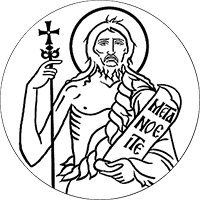Nectarius (Kephalas), metropolitan of Pentapolis, wonderworker of Aegina, holy hierarch
Dates of commemoration
(Church calendar - Jan 2) In memory of the rehabilitation of the hierarch by the Church of Alexandria in 1998 (Greek)
(Church calendar - Aug 21) Translation of the relics in 1953 (Greek)
Life
St. Nectarios was born on October 1, 1846, in Selymbria in Thrace to a poor family. His given name was Anastasios Cephalas. At the age of 14 he moved to Constantinople (Istanbul) to work and further his education. In 1866 he left to the island of Chios to take a teaching post. He then became a monk at the age of thirty.
Three years after becoming a monk he was ordained a deacon, taking the name Nectarios. He graduated from the University of Athens in 1885. During his years as a student of the University of Athens he wrote many books, pamphlets, and Bible commentaries.
Following his graduation he went to Alexandria, Egypt, where he was ordained a priest and served the Church of Saint Nicholas in Cairo with great distinction. In recognition of his piety and brilliance as a preacher, as well as his administrative ability, he was consecrated Bishop/Metropolitan of Pentapolis (an ancient diocese in Cyrenaica, in what is now Libya) by the Greek Orthodox Patriarch Sophronios in 1889.
He served as a bishop in Cairo for one year, but was then unjustly removed from his post and was also anathematised. This was a result of lies made up by jealous clerics who envied his popularity with the people. Patriarch Sophronios refused to listen to St. Nectarios, who was sent away from Egypt without trial or explanation and was never given an opportunity to defend himself.
After his dismissal, he returned to Greece in 1891 and spent several years as a preacher (1891-1894). He was then appointed director of the Rizarios Ecclesiastical School for the education of priests in Athens, where his service was exemplary for fifteen years. He developed many courses of study and wrote numerous books, all while preaching widely throughout Athens.
In 1904 at the request of several nuns, he established a monastery for them on the island of Aegina. The monastery was named Holy Trinity Monastery.
In December of 1908, at the age of 62, St. Nectarios resigned from his post as school director and withdrew to the Holy Trinity Convent on Aegina, where he lived out the rest of his life as a monk. He wrote, published, preached, and heard confessions from those who came from near and far to seek out his spiritual guidance.
While at the monastery, he also tended the gardens, carried stones, and helped with the construction of the monastery buildings that were built with his own funds. He was also the Metropolitan of the island of Aegina.
St. Nectarios died on the evening of November 8, 1920, at the age of 74, following hospitalization for prostate cancer. The commemoration date was set at the next day, November 9, because November 8 is the feast of Synaxis of Archangel Michael. The first posthumous miracle took place when the shirt of St. Nectarios was accidentally placed on the neighboring bed: a paralyzed man who was lying there was suddenly healed. The body of St. Nectarios was taken to the Holy Trinity Convent, where he was buried by the only clergyman- his best friend and spiritual brother Saint Savas the new of Kalymnos, who later painted the first icon of St. Nectarios. The funeral of St. Nectarios was attended by multitudes of people.
Many people regarded St. Nectarios as a saint during his lifetime because of his prayerful life, his humility, his purity and other virtues, and his writings, as well as the miracles he performed. St. Nectarios also had the gift of prescience.
The relics of St. Nectarios were removed from the grave on September 2, 1953, and gave out a beautiful fragrance. Official recognition of Nectarios as a saint by the Ecumenical Patriarchate of Constantinople took place on April 20, 1961. Thousands of miracles have been attributed to his intercession, particularly cases of cancer or other serious illnesses being cured.
Source:
https://orthodoxwiki.org/Nectarios_of_Pentapolis
Holy relic type
unless specified otherwise below, "holy relic" means a fragment of a bone of the saint
Holy relic
Location of the holy relic in the Cathedral:
Icon of holy hierarch Nectarius, west wall of the nave, south corner
Troparion
Tone 1
O faithful, let us honor Nectarios, divine servant of Christ, offspring of Silivria and guardian of Aegina, who in these latter years was manifested as the true friend of virtue. All manner of healing wells forth for those who in piety cry out, "Glory to Christ who glorified you; glory to Him who, through you, wrought wonders; glory to Him who, through you, works healing for all."
Kontakion
Tone 2
In joy of heart let us hymn with songs the newly revealed star of Orthodoxy, the newly erected bulwark of the Church; for, glorified by the activity of the Spirit, he poureth forth the abundant grace of healing upon those who cry: Rejoice, O Father Nektarios, model of patience and lover of virtue.






